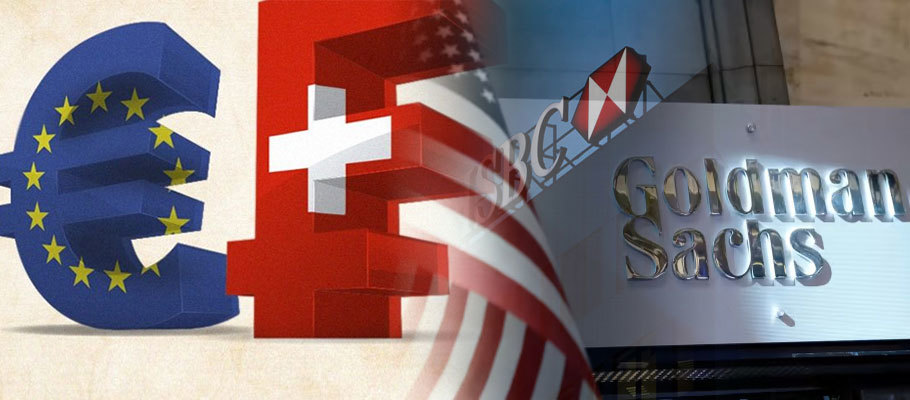
Published: May 11th, 2022
Analysts at Goldman Sachs have published a new research briefing saying the EUR/CHF exchange rate could fall to parity or go even lower, something the global investment bank thinks would be welcomed by the Swiss National Bank (SNB).
‘We are now looking for EUR/CHF to trade under parity over the coming year, and ultimately inch towards 0.94,’ read a briefing published by Goldman’s Global FX Strategy unit in London.
Goldman’s view is in sharp contrast to one expressed by analysts at HSBC earlier this week, saying they don’t anticipate the EUR/CHF exchange rate to fall back to parity, but see looming Franc weakness instead.
The debate on the pair’s exchange rate outlook comes as the Euro to Franc exchange rate hits seven consecutive days of advances, reaching 1.0486 at time of writing.
Back on 8th March the pair did fall briefly below the psychologically important 1.0 level, however the drop wasn’t sustained and didn’t push the pair to a lower daily close.
Still, Goldman Sachs sees the last week’s period of strength as temporary in nature. Ultimately, it says, powerful fundamental forces will drag CHF back down.
‘The trend we're basing our outlook on is defined by the widening differential in inflation between the two countries,’ Goldman’s note reads. ‘To maintain stability in the real exchange rate, EUR/CHF will have to keep moving lower.’
Rather than simply let the market work, Goldman thinks the Swiss central bank should actively encourage the gradual downtrend.
The Swiss National Bank is one of the most activist central banks in terms of intervening in currency markets, often battling prevailing market trends to keep CHF affordable, ensuring Swiss exporters stay competitive and protecting Switzerland's balance of trade.
True to form, recent data on the SNB's currency holdings indicates bank authorities are moving to influence market trends.
HSBC’s European FX Research Unit said in a market analysis that the central bank’s sight deposits, used as a proxy for SNB forex interventions, grew suddenly by CHF 6.5 billion on 6th May, the biggest weekly jump since June of 2020.’
That development continues an emerging trend which started in late March when sight deposits began to rise gradually. That increased level of market intervention could be because speculative trading or unpredictable ‘hot money’ might be driving recent CHF moves.
By using sight deposits to control flows, the SNB hopes it can control and contain the Franc's value.
As a tactic it stands in contrast to currency moves driven by international trade, which HSBC says the SNB is less willing to fiddle with.
The bank’s analysts also say the alpine nation’s lower inflation rates vis a vis the Eurozone will influence the Franc’s outlook.
Switzerland’s April CPI reading was lower than expected and still modest relative to other major economies, reaching just 1.6 per cent year-on-year.
‘Lower inflation would only be aggravated by a stronger currency, which is why the SNB is likely more prepared to counter CHF strength.’
Countering that opinion, Goldman Sachs argues that the SNB will move against inflation, rather than welcome it. If that’s the case, then bank policymakers won't want the Franc to depreciate substantially.
SNB Governor Thomas Jordan told Bloomberg that the central bank has room to maneuver and can leave the Swiss fiat to appreciate in nominal terms.
‘Higher global inflation is giving us more flexibility to do this’, Jordan said.
Goldman notes however that the SNB deliberately let the Franc appreciate modestly as a way to keep the real exchange rate stable and battle inflation pressures.
‘For that reason, we don’t expect CHF to be set free and allowed to depreciate as the Yen was a month ago. We believe the SNB will follow any tightening action from the ECB closely.’
Meanwhile, the Euro to Dollar rate (EUR/USD) leapt upward on Thursday 5th May in the wake of the Federal Reserve's decision to raise rates by 50 basis points. Any gains may turn out to be fleeting, however, and Credit Suisse analysts believe further losses are likely.
Having leapt to a high of 1.0640, Fed Chair Jerome Powell said no to a more robust 75 basis point rise in July. The pair has since settled back to 1.0589 at time of writing.
If the Euro is unable to hold its post-Fed gains, then forex traders will shift focus to downside risks.
In an analyst note, Credit Suisse’s Forex Strategy unit said that ‘we can’t rule out the possibility of moves like EUR/USD falling below parity in the coming months.’
Credit Suisse says it shouldn’t come as a surprise that the Federal Reserve didn’t deliver the sort of 'hawkish' surprise that might have spurred another serious round of Dollar buying.
But the investment bank says say the probability of an extended series of rate hikes will ultimately be supportive of the greenback against the Euro.
US-based economists at Credit Suisse are watching for two more consecutive 50bp hikes to complete the final 200 basis points of hikes they say could arrive through the remainder of 2022, complemented by another 100bp next year. If that approach does come to fruition, then the Fed will have been more aggressive than the market.
‘Our view is generally bullish on USD as a result.’ The bank currently maintains a EUR/USD forecast of 1.0339. ‘For us, the fact that the greenback has ascended to the lofty levels last seen in April 2020 is not a rationale for Dollar negativity.
If anything, the bank says, the risk balance for the pair has shifted to the downside.
‘We can’t completely rule out moves like EUR/USD dipping below parity in the coming months, but given the divergence in inflation we still see the direction US rates going higher’.